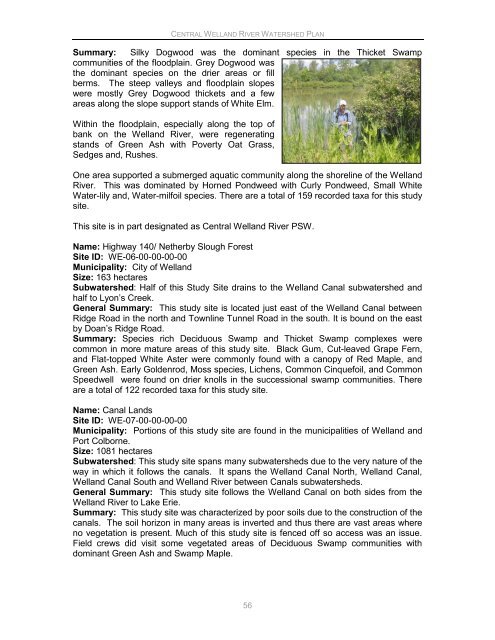Central Welland River Watershed Plan - Niagara Peninsula ...
Central Welland River Watershed Plan - Niagara Peninsula ...
Central Welland River Watershed Plan - Niagara Peninsula ...
- No tags were found...
You also want an ePaper? Increase the reach of your titles
YUMPU automatically turns print PDFs into web optimized ePapers that Google loves.
CENTRAL WELLAND RIVER WATERSHED PLANSummary: Silky Dogwood was the dominant species in the Thicket Swampcommunities of the floodplain. Grey Dogwood wasthe dominant species on the drier areas or fillberms. The steep valleys and floodplain slopeswere mostly Grey Dogwood thickets and a fewareas along the slope support stands of White Elm.Within the floodplain, especially along the top ofbank on the <strong>Welland</strong> <strong>River</strong>, were regeneratingstands of Green Ash with Poverty Oat Grass,Sedges and, Rushes.One area supported a submerged aquatic community along the shoreline of the <strong>Welland</strong><strong>River</strong>. This was dominated by Horned Pondweed with Curly Pondweed, Small WhiteWater-lily and, Water-milfoil species. There are a total of 159 recorded taxa for this studysite.This site is in part designated as <strong>Central</strong> <strong>Welland</strong> <strong>River</strong> PSW.Name: Highway 140/ Netherby Slough ForestSite ID: WE-06-00-00-00-00Municipality: City of <strong>Welland</strong>Size: 163 hectaresSubwatershed: Half of this Study Site drains to the <strong>Welland</strong> Canal subwatershed andhalf to Lyon‟s Creek.General Summary: This study site is located just east of the <strong>Welland</strong> Canal betweenRidge Road in the north and Townline Tunnel Road in the south. It is bound on the eastby Doan‟s Ridge Road.Summary: Species rich Deciduous Swamp and Thicket Swamp complexes werecommon in more mature areas of this study site. Black Gum, Cut-leaved Grape Fern,and Flat-topped White Aster were commonly found with a canopy of Red Maple, andGreen Ash. Early Goldenrod, Moss species, Lichens, Common Cinquefoil, and CommonSpeedwell were found on drier knolls in the successional swamp communities. Thereare a total of 122 recorded taxa for this study site.Name: Canal LandsSite ID: WE-07-00-00-00-00Municipality: Portions of this study site are found in the municipalities of <strong>Welland</strong> andPort Colborne.Size: 1081 hectaresSubwatershed: This study site spans many subwatersheds due to the very nature of theway in which it follows the canals. It spans the <strong>Welland</strong> Canal North, <strong>Welland</strong> Canal,<strong>Welland</strong> Canal South and <strong>Welland</strong> <strong>River</strong> between Canals subwatersheds.General Summary: This study site follows the <strong>Welland</strong> Canal on both sides from the<strong>Welland</strong> <strong>River</strong> to Lake Erie.Summary: This study site was characterized by poor soils due to the construction of thecanals. The soil horizon in many areas is inverted and thus there are vast areas whereno vegetation is present. Much of this study site is fenced off so access was an issue.Field crews did visit some vegetated areas of Deciduous Swamp communities withdominant Green Ash and Swamp Maple.56
















